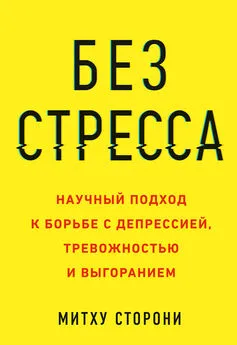Митху Сторони - Без стресса. Научный подход к борьбе с депрессией, тревожностью и выгоранием
- Название:Без стресса. Научный подход к борьбе с депрессией, тревожностью и выгоранием
- Автор:
- Жанр:
- Издательство:Литагент МИФ без БК
- Год:2019
- Город:Москва
- ISBN:978-5-00117-633-6
- Рейтинг:
- Избранное:Добавить в избранное
-
Отзывы:
-
Ваша оценка:
Митху Сторони - Без стресса. Научный подход к борьбе с депрессией, тревожностью и выгоранием краткое содержание
На русском языке публикуется впервые.
Без стресса. Научный подход к борьбе с депрессией, тревожностью и выгоранием - читать онлайн бесплатно ознакомительный отрывок
Интервал:
Закладка:
156
O. A. Coubard. «An Integrative Model for the Neural Mechanism of Eye Movement Desensitization and Reprocessing (EMDR)». Frontiers in Behavioral Neuroscience 10 (2016): 52.
157
https://www.youtube.com/watch?v=nylajeG6uFY. Retrieved August 5, 2016.
158
C. Acarturk, E. Konuk, M. Cetinkaya, I. Senay, M. Sijbrandij, B. Gulen, and P. Cuijpers, «The Efficacy of Eye Movement Desensitization and Reprocessing for Post-traumatic Stress Disorder and Depression among Syrian Refugees: Results of a Randomized Controlled Trial». Psychological Medicine 46, no. 12 (Sept. 2016): 2583–2593.
159
M. Maroufi, S. Zamani, Z. Izadikhah, M. Marofi, and P. O’Connor, «Investigating the Effect of Eye Movement Desensitization and Reprocessing (EMDR) on Postoperative Pain Intensity in Adolescents Undergoing Surgery: A Randomized Controlled Trial». Journal of Advanced Nursing 72, no. 9 (Sept. 2016): 2207–2217.
160
R. N. McLay, J. A. Webb-Murphy, S. F. Fesperman, E. M. Delaney, S. K. Gerard, S. C. Roesch, B. J. Nebeker, I. Pandzic, E. A. Vishnyak, and S. L. Johnston, «Outcomes from Eye Movement Desensitization and Reprocessing in Active-Duty Service Members with Posttraumatic Stress Disorder». Psychological Trauma 8, no. 6 (Mar. 2016): 702–708.
161
M. Banasr, G. W. Valentine, X. Y. Li, S. L. Gourley, J. R. Taylor, and R. S. Duman, «Chronic Unpredictable Stress Decreases Cell Proliferation in the Cerebral Cortex of the Adult Rat.» Biological Psychiatry 62, no. 5 (Sept. 2007): 496–504.
162
E. Blix, A. Perski, H. Berglund, and I. Savic, «Long-term Occupational Stress is Associated with Regional Reductions in Brain Tissue Volumes». PLoS ONE8 , no. 6 (Jun. 2013): e64065.
163
C. D. Gipson and M. F. Olive, «Structural and Functional Plasticity of Dendritic Spines – Root or Result of Behavior?» Genes, Brain and Behavior 2017 16, no. 1 (Jan. 2017): 101–117.
164
V. Pinto, J. C. Costa, P. Morgado, C. Mota, A. Miranda, F. V. Bravo, T. G. Oliveira, J. J. Cerqueira, and N. Sousa, «Differential Impact of Chronic Stress Along the Hippocampal Dorsal-ventral Axis». Brain Structure and Function 220, no. 2 (Mar. 2015): 1205–1212.
165
A. Ashokan, A. Hegde, and R. Mitra, «Short-term Environmental Enrichment is Sufficient to Counter Stress-induced Anxiety and Associated Structural and Molecular Plasticity in Basolateral Amygdala». Psychoneuroendocrinology 69 (Jul. 2016): 189–196.
166
A. N. Sharma, E. da Costa, B. F. Silva, J. C. Soares, A. F. Carvalho, and J. Quevedo, «Role of Trophic Factors GDNF, IGF-1 and VEGF in Major Depressive Disorder: A Comprehensive Review of Human Studies». Journal of Affective Disorders 197 (Jun. 2016): 9–20.
167
M. E. Maynard, C. Chung, A. Comer, K. Nelson, J. Tran, N. Werries, E. A. Barton, M. Spinetta, and J. L. Leasure, «Ambient Temperature Influences the Neural Benefits of Exercise». Behavioural Brain Research 299 (Feb. 2016): 27–31.
168
N. M. Vega-Rivera, L. Ortiz-López, A. Gómez-Sánchez, J. OikawaSala, E. M. Estrada-Camarena, and G. B. Ramírez-Rodríguez, «The Neurogenic Effects of an Enriched Environment and its Protection against the Behavioral Consequences of Chronic Mild Stress Persistent after Enrichment Cessation in Six-month-old Female Balb/C Mice». Behavioural Brain Research 301 (Mar. 2016): 72–83.
169
E. Castilla-Ortega, C. Rosell-Valle, C. Pedraza, F. Rodríguez de Fonseca, G. Estivill-Torrús, and L. J. Santín, «Voluntary Exercise Followed by Chronic Stress Strikingly Increases Mature Adult-born Hippocampal Neurons and Prevents Stress-induced Deficits in ‘What-when-where’ Memory». Neurobiology of Learning and Memory 109 (Mar. 2014): 62–73.
170
H. van Praag, G. Kempermann, and F. H. Gage, «Running Increases Cell Proliferation and Neurogenesis in the Adult Mouse Dentate Gyrus». Nature Neuroscience 2, no. 3 (Mar. 1999): 266–270.
171
S. A. Neeper, F. Gomez-Pinilla, J. Choi, and C. W. Cotman, «Physical Activity Increases mRNA for Brain-derived Neurotrophic Factor and Nerve Growth Factor in Rat Brain». Brain Research 726 (1996): 49–56.
172
M. S. Nokia, S. Lensu, J. P. Ahtiainen, P. P. Johansson, L. G. Koch, S. L. Britton, and H. Kainulainen, «Physical Exercise Increases Adult Hippocampal Neurogenesis in Male Rats Provided it is Aerobic and Sustained». Journal of Physiology 594, no. 7 (Apr. 2016): 1855–1873.
173
K. Inoue, M. Okamoto, J. Shibato, M. C. Lee, T. Matsui, R. Rakwal, and H. Soya, «Long-term Mild, Rather than Intense, Exercise Enhances Adult Hippocampal Neurogenesis and Greatly Changes the Transcriptomic Profile of the Hippocampus». PLoS ONE10 , no. 6 (Jun. 2015): e0128720.
174
A. Dinoff, N. Herrmann, W. Swardfager, C. S. Liu, C. Sherman, S. Chan, and K. L. Lanctôt, «The Effect of Exercise Training on Resting Concentrations of Peripheral Brain-Derived Neurotrophic Factor (BDNF): A Meta-Analysis». PLoS ONE11 , no. 9 (Sept. 2016): e0163037.
175
K. I. Erickson, M. W. Voss, R. S. Prakash, C. Basak, A. Szabo, L. Chaddock, J. S. Kim, S. Heo, H. Alves, S. M. White, T. R. Wojcicki, E. Mailey, V. J. Vieira, S. A. Martin, B. D. Pence, J. A. Woods, E. McAuley, and A. F. Kramer, «Exercise Training Increases Size of Hippocampus and Improves Memory». Proceedings of the National Academy of Sciences of the United States of America 108, no. 7 (Feb. 2011): 3017–3022.
176
C. H. Hillman, K. I. Erickson, and A. F. Kramer, «Be Smart, Exercise Your Heart: Exercise Effects on Brain and Cognition». Nature Reviews Neuroscience 9, no. 1 (Jan. 2008): 58–65.
177
M. Zagaar, A. Dao, A. Levine, I. Alhaider, and K. Alkadhi, «Regular Exercise Prevents Sleep Deprivation Associated Impairment of Long-term Memory and Synaptic Plasticity in the CA1 Area of the Hippocampus». Sleep 36, no. 5 (May 2013): 751–761.
178
T. Kobilo, Q. R. Liu, K. Gandhi, et al., «Running is the Neurogenic and Neurotrophic Stimulus in Environmental Enrichment». Learning & Memory 18 (2011): 605–609.
179
G. Wagner, M. Herbsleb, F. Cruz, A. Schumann, F. Brünner, C. Schachtzabel, A. Gussew, C. Puta, S. Smesny, H. W. Gabriel, J. R. Reichenbach, and K. J. Bär, «Hippocampal Structure, Metabolism, and Inflammatory Response after a 6-week Intense Aerobic Exercise in Healthy Young Adults: A Controlled Trial». Journal of Cerebral Blood Flow & Metabolism 35, no. 10 (Oct. 2015): 1570–1578.
180
Провоспалительный – ухудшающий течение заболевания.
181
C. J. Heyser, E. Masliah, A. Samimi, I. L. Campbell, and L. H. Gold, «Progressive Decline in Avoidance Learning Paralleled by Inflammatory Neurodegeneration in Transgenic Mice Expressing Interleukin 6 in the Brain». Proceedings of the National Academy of Sciences of the United States of America 94 (1997): 1500–1505.
182
D. L. Gruol, «IL-6 Regulation of Synaptic Function in the CNS». Neuropharmacology 96 (2015): 42–54, doi: 10.1016/j.neuropharm.2014.10.023.
183
M. A. Ajmone-Cat, E. Cacci, and L. Minghetti, «Non Steroidal Antiinflammatory Drugs and Neurogenesis in the Adult Mammalian Brain». Current Pharmaceutical Design 14, no. 14 (2008): 1435–1442.
184
Анаэробный (лактатный) порог – уровень, при достижении которого клетки начинают получать энергию не только аэробным путем (при участии кислорода), но и анаэробным (гликолиз). Это происходит при выполнении нагрузок высокой интенсивности. При этом накапливается лактат и возрастает гликолитический компонент в энергетическом метаболизме, что создает условия для развития атеросклеротических процессов, инсулинорезистентности и новообразований.
185
K. Inoue, M. Okamoto, J. Shibato, M. C. Lee, T. Matsui, R. Rakwal, and H. Soya, «Long-term Mild, Rather than Intense, Exercise Enhances Adult Hippocampal Neurogenesis and Greatly Changes the Transcriptomic Profile of the Hippocampus». PLoS ONE10 , no. 6 (Jun. 2015): e0128720.
186
M. E. Maynard, C. Chung, A. Comer, K. Nelson, J. Tran, N. Werries, E. A. Barton, M. Spinetta, and J. L. Leasure, «Ambient Temperature Influences the Neural Benefits of Exercise». Behavioural Brain Research 299 (Feb. 2016): 27–31.
187
G. Umschweif, D. Shabashov, A. G. Alexandrovich, V. Trembovler, M. Horowitz, and E. Shohami, «Neuroprotection after Traumatic Brain Injury in Heat-acclimated Mice Involves Induced Neurogenesis and Activation of Angiotensin Receptor Type 2 Signaling». Journal of Cerebral Blood Flow & Metabolism 34, no. 8 (2014): 1381–1390.
188
V. Bhagya, B. N. Srikumar, J. Veena, and B. S. Shankaranarayana Rao, «Short-term Exposure to Enriched Environment Rescues Chronic Stress-induced Impaired Hippocampal Synaptic Plasticity, Anxiety, and Memory Deficits». Journal of Neuroscience Research (Nov. 2016) ( epub ahead of print), doi: 10.1002/jnr.23992.
189
T. Novkovic, T. Mittmann, and D. Manahan-Vaughan, «BDNF Contributes to the Facilitation of Hippocampal Synaptic Plasticity and Learning Enabled by Environmental Enrichment». Hippocampus 25, no. 1 (Jan. 2015): 1–15.
190
J. Aarse, S. Herlitze, and D. Manahan-Vaughan, «The Requirement of BDNF for Hippocampal Synaptic Plasticity is Experiencedependent». Hippocampus 26, no. 6 (Jun. 2016): 739–751.
191
A. Ashokan, A. Hegde, and R. Mitra, «Short-term Environmental Enrichment is Sufficient to Counter Stress-induced Anxiety and Associated Structural and Molecular Plasticity in Basolateral Amygdala». Psychoneuroendocrinology 69 (Jul. 2016): 189–196.
192
G. D. Clemenson and C. E. L. Stark, «Virtual Environmental Enrichment through Video Games Improves Hippocampal-Associated Memory». Journal of Neuroscience 35, no. 49 (Dec. 2015): 16116–16125.
193
S. Seinfeld, H. Figueroa, J. Ortiz-Gil, and M. V. Sanchez-Vives, «Effects of Music Learning and Piano Practice on Cognitive Function, Mood and Quality of Life in Older Adults». Frontiers in Psychology 4 (2013): 810.
194
J. Oltmanns, B. Godde, A. H. Winneke, G. Richter, C. Niemann, C. Voelcker-Rehage, K. Schömann, and U. M. Staudinger, «Don’t Lose Your Brain at Work – The Role of Recurrent Novelty at Work in Cognitive and Brain Aging». Frontiers in Psychology 8 (2017): 117.
Читать дальшеИнтервал:
Закладка:









